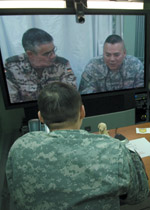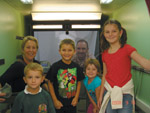Telepresence Benefits Two Fronts
 |
| NATO’s telepresence trial linking Europe with Kabul provided an immersive, face-to-face virtual meeting capability for command staff. |
NATO is exploring the benefits that telepresence capabilities offer military commanders and military families. The organization established a high-capacity communications link between several sites in Europe and
A meeting early last year between NATO Communication and Information Systems (CIS) Services Agency (NCSA) Director Lt. Gen. Ulrich H.M. Wolf, GEA, and Cisco Systems Incorporated prompted a test of the capability. The goal was to put the system out into the troops’ hands to demonstrate innovation.
Working with General Dynamics C4 Systems and British Telecom, Cisco coordinated with the NCSA staff to produce a telepresence system that could be sent into the field in a premounted transportable container and deployed around
A single telepresence system used during the trial comprised two units. “We kept one in
The equipment is being sent to Bischofswiesen, the location of troops scheduled for
While the system originally was conceived as a communication and information system and decision-making tool focused on high-level decision makers, NATO quickly realized that it could fill a second role: providing invaluable support for welfare communications by connecting deployed soldiers with their families at home.
The team recognized that spare time was available in the system. “The generals and staff officer would use it for short periods, and it would sit idle for the rest of the day. Together with Cisco, British Telecom and General Dynamics, the NCSA decided that we could easily use that time to benefit the soldiers and their families, and we offered that free time for family care opportunities,” he says.
In allowing family access, the NCSA’s approach has been to emphasize quality of experience over the number of sessions per day. “We tried to give the families as much time as possible; at least 15 minutes per family, purely talking. That means they come into the shelters to sit down and familiarize themselves with the system before providing them with 15 minutes of talk time. That has given them a lot of time to exchange a lot of emotion and information because that is what they want. The feedback from soldiers and their families was marvelous. We could not imagine better feedback,” he adds. The trial ended in mid-December; the system is being brought back to
Tactical videoconferencing systems typically use 128 kilobits per second (Kbps) and 256-Kbps lines. Not so with telepresence. For the trial, British Telecom provided an X-band military satellite communication link over the X-STAR system. Throughput is considerable. The NATO implementation of telepresence uses 3 megabits per second (Mbps), which is at the lower end of the bandwidth required for telepresence; normally it would consume around 5 Mbps.
The communication standard is Cisco proprietary because a standard has not yet been defined for this quality. The telepresence is interoperable through the use of transcoding equipment in the package. The system provides the transcoding and interoperability with other systems. Higher-resolution protocols have not yet been developed, and compression methods remain the major issue. The raw data is around 5 gigabits per second, and Cisco developed the compression protocol and uses transcoding products that can then be connected to standardized areas.
The technical engineer explains, “We don’t describe this product as a teleconferencing capability; it is called telepresence for a reason. You are sitting in the shelter, and you have the impression that the person in the other unit is actually sitting in front of you. Design rules say that the person on the monitor should be shown life-size, one-to-one scale. If in real life, he is 1.80 meters [5 feet, 9 inches] tall, then he should be 1.80 meters on the monitor. It gives you a very high resolution, up to 1,080 pixels high definition.”
The NATO trials used standard NATO Type 1 encryption derived from the Thales 621B program. The cryptography can protect up to NATO Top Secret. “Although we can use it in NATO Secret, or up to Top Secret, the trial version was not accredited,” the system’s technical engineer explains. “We demonstrated that it was technically possible to do both, but to call the system NATO Secret, another step is necessary: accreditation. We did not initiate that during the trial version. We did the technical steps to secure it to NATO Secret, but we didn’t follow the procedural steps to certify the whole installation in the NATO Secret mode.”
The trial was designed to determine whether such a capability would benefit users. “The idea behind the trial was to give the operational users the opportunity to see the equipment and to see if they have an operational requirement for telepresence instead of videoconferencing,” he continues. “We also have to add that this is one system that is on the market; other enterprises provide similar systems.
 |
| When the telepresence technology was not being operated for command and control meetings, staff members used it to connect with family members in the United States. Note that a father is actually on the video screen behind the children. |
NATO does not consider telepresence a replacement technology but rather a supplemental technology for conferences when videoconferencing is not sufficient. The technical engineer explains that telepresence technologies provide nearly the same quality as if sitting at a big table in the conference room. “We have to dive in a little bit into social structures here. These normally start with critical meetings where you learn about the people you are dealing with, and afterward you communicate with them by telephone, e-mail or videoconferencing because in principle the first physical meeting should be to learn about the people themselves. Telepresence more than fulfills the first role. After that, you can normally rely on the distance conference to continue communication,” the technical engineer proposes.
“When I saw it for the first time, I compared it to a real movie. You can really see emotions on the faces, you really can see how people act, and you get a brilliant picture of gesture and meaning. This is very important if you want to read between the lines. It saves on travel costs, but it is the savings in time that we were really looking for. We don’t foresee that it will replace tactical videoconferencing,” he adds.
Web Resource
NATO Communication and Information Systems Services Agency: www.ncsa.nato.int




Comments